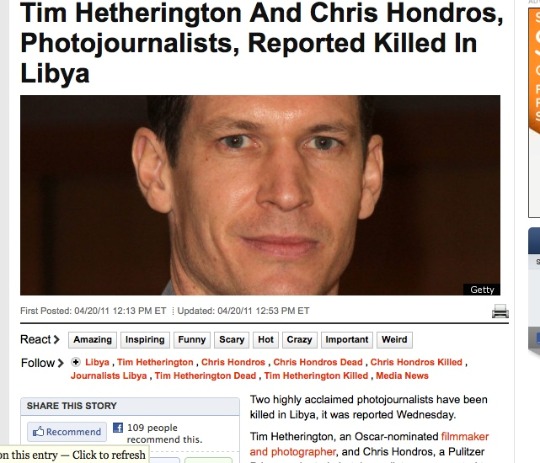Sign up for the daily CJR newsletter.
There has been much confusion in the wake of reports that documentary filmmaker Tim Hetherington was killed today in Misrata, Libya, and three other photographers were injured, two gravely.
Initial reports were that Hetherington and photographer Chris Hondros were both killed—but the Times and others are now reporting that Hondros and photographer Guy Martin are in grave condition rather than dead.
The Huffington Post, Business Insider, and others initially reported that Hondros had died based on a post on fellow photographer Andre Liohn’s Facebook page. Liohn had apparently updated his page earlier today to say that Hondros had died along with Hetherington.

Announcements and condolences soon followed on Twitter for both journalists. And then the story started to change. An early hint was a post by CNN’s Joneil Adriano that said:
CNN has learned that one photojournalist was killed in Libya, another injured. We are not identifying them until next of kin are notified.
Soon a number of outlets were correcting their initial reporting on blogs and on Twitter. Vanity Fair, for whom Hetherington was a contributor, tweeted:
Correction: Tim Hetherington’s death has been confirmed. Chris Hondros remains in grave condition.
Not too long after that, the Times was up with a story from C.J. Chivers in Benghazi. Chivers reports:
Mr. Hondros, an American working for the Getty photo agency, suffered a severe brain injury and was in extremely critical condition, according to a colleague who was with at the triage center. He had been revived and was clinging to life in the evening, the colleague said.
Mr. Martin, a British citizen working for the Panos photo agency, had shrapnel wounds and was undergoing vascular surgery Wednesday night, according to the same account. He was in surgery Wednesday night.
The fourth photographer, Michael Christopher Brown, suffered shrapnel injuries but his life was not in danger.
This is terrible news. And it may get worse. But we can draw some quick lessons from the unfolding story—and the way it’s unfolded—just as quickly as some have rushed to conclusions.
The first is that, like the Gabby Giffords case, and others before it, it is always necessary to wait for confirmation of facts when the facts in question are so sensitive. Here, it appears, those who did not wait got the story wrong. And if it is true that outlets went ahead and published reports of these deaths before contact had been made with the next of kin, then this is particularly tragic. Everybody wants to be first—especially in this super fast day and age—but basic principles must hold.
Another basic principle that must hold is sourcing. And if, as initial reports suggest, the only source for the initial story was the Facebook update, it should be obvious to anyone, even the most desk-weary blogger, that this is not strong enough information on which to announce a death, no matter who is posting the update. Not when we’re reporting on death. And especially not before the next of kin would have been told.
Finally, we can relearn today that when a mistake like this is made—and it is regrettable though in some ways inevitable given the speed with which misinformation travels—we handle it professionally, own up to it, correct ourselves, and regret the error. Most outlets have done this. Though not always with the speed with which the original stories were reported.
Has America ever needed a media defender more than now? Help us by joining CJR today.






